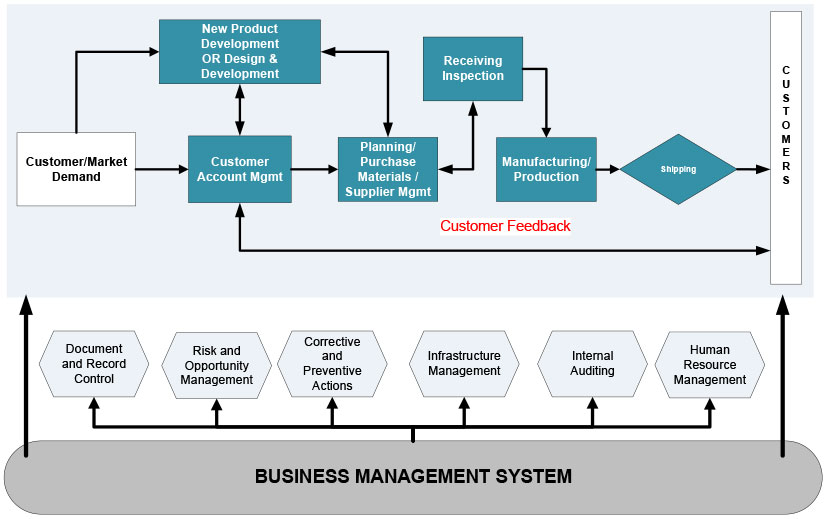Documenting a Business Management System is essential if you are looking to scale your business or obtain certification required by your industry and/or customers. A Business Management System is a set of documents that outline what your business does, your business objectives, and how you achieve those objectives. The primary goal of all businesses is to deliver quality product and/or service, on time, to their customers to ensure customer satisfaction and customer retention. Therefore, the ISO 9001:2015 Quality Management System is generally used as a foundation when organizations, small, medium, and large, set out to document their Business Management System. The following tips are outlined to help you effectively and efficiently document your business scope, processes, and procedures. For additional assistance with writing your documentation complete our Initial Engagement Questionnaire.
When documenting your Business Management System, some of the key things to know and apply:
- The first step is to document the scope of your business. The Scope of your Business is a simple statement documenting what your business does – what are your business’ key activities (i.e. manufacturing and sale of parts for the aviation industry; design and development of patient monitoring devices; distribution of nuts and bolts for various industries; purchase, testing and re-sale of used electronics; etc…)
- Once the scope of your business is documented, the next step is to document a flow-chart to show how these key, high level activities/processes, interact with each other. (See Figure I for reference). In ISO standards, this type of flow-chart is defined as an ‘Interaction of Processes’ and is one of they key documents used when implementing, documenting, and auditing ISO standards.
- Processes are higher level documents that describe primary inputs and outputs.
- The output(s) from each process is likely to be an input into the next process. Note that in Figure 1 there are two-way arrows connecting several processes. This means that outputs form these processes are inputs into another process. The reason for two-way arrows is because some of the final process outputs cannot be completed until the connecting process input is confirmed (i.e. Purchasing defines the requirements for Receiving Inspections on each Purchase Order, but Purchasing is not able to monitor and maintain an Approved Vendor list without the results of the Receiving Inspection results).
- Individual Process documents can be as general or as detailed as you would like them to be, or as it is appropriate for your organization.
- The more detailed your process is, the less likely you will need supporting processes or work instructions – but this all depends on the complexity of your business and size of the organization.
- The less detailed your process is, the more likely you will need more detailed documents like procedures and work instructions to further outlined the requirements that will support the primary goals such as quality of the product, customer satisfaction, on-time delivery, positive environmental and health & safety performance, etc…
- Inputs and/or outputs are best if they are recorded/documented in your customer relation management (CRM), enterprise resource planning (ERP) software and/or templates generated to track the orders, etc… Once you identify where you are recording these primary inputs and outputs, writing your key processes and procedures will be relatively easy. In other words, your processes and procedures will be written in a manner that they will tell a story of how all of the inputs and outputs are connected all the way from Customer Account Management, through Purchasing (including management of outsourced processes), Receiving, Design and Development, Manufacturing or De-manufacturing, Shipping, and Customer Satisfaction.
- Finally, some of the supporting procedures documented on Figure I (i.e. Document and Record Control, Corrective and Preventive Action, and Infrastructure Management) are those processes or procedures that support your whole business operation and are to be implemented and trained to each of your departments. Choosing which supporting business processes and procedures you want to document will depend on your organization, industry, and/or standard(s) you are seeking to implement.

Table I: Common Inputs and Outputs for General Industry*
|
|
Customer Account Management |
Purchasing and Suppler Management |
Design and Development (DD) |
Operations |
Receiving |
Shipping |
|
Inputs |
Customer Request | Work Order from Customer Accounts or Operations | Customer Requirements | Work Order | PO requirements (supplies or outsourced vendor) | Work Order |
| Business Development Observe the Market | Purchase Request | Legal, Regulatory, Industry Requirements | DD Drawing | |||
| Customer Accept Quote and/or Make an Order | Resource Planning or Capacity Plan | Product requirements | BOM | |||
| **All of this is defined in Design and Development Inputs | ||||||
|
Outputs |
Review of Customer Request (i.e. Document Quote to send to customer) | Supplier/Vendor Approvals (including all documents related to approvals) | DD outputs | Product | Completed receiving inspection | Shipping Records |
| Commit to Customer Requirement | Supplier/Vendor Monitoring and Re-evaluation | Build of Materials | (BOM) | Traveler | Inventory | |
| Record or issue Work Order to Operations | Issued Purchase Order | Engineering Package (including DD Drawing) | Final Inspections | |||
| Customer feedback, complaints | Inventory | |||||
| Customer Survey and Customer Satisfaction |
*This is only a sample, this does not include all possible inputs and outputs.
